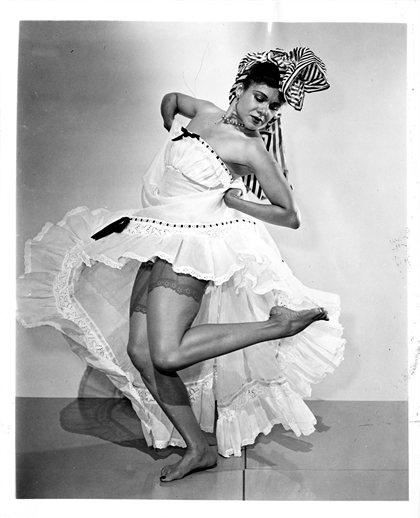Creolizing dance in a global age
The Creolizing dance in a global age symposium explored the dynamics ‘creolization’ as a change-maker in the dance world, in order to generate a new vocabulary for engagement, diversity and dance.

The symposium took place on 21 May 2014 in the Anatomy Museum and Anatomy Lecture Theatre, King's College London and was led by Professor Ananya Kabir, Department of English and Pawlet Brookes, Creative Director, Serendipity. It brought to London key dancers, cultural producers and academics from the Caribbean and North America, who initiated dialogue between cutting-edge academic debates on creolization processes in the Americas and the Indian Ocean, and dance practice that highlights their continuation in the multicultural present.
Through unique curated conversations punctuated with path-breaking dance interventions, the symposium began the much-needed process of naming, nuancing and analyzing work that has hitherto been subsumed under the broad banner of ‘black dance’.
Creolizing dance showcased ‘black dance’ as comprised of multiple cultural encounters between different heritage groups that have taken place historically in Plantation spaces where Indians, Africans, Chinese and Europeans, all uprooted through the processes of Empire, exchanged music, dance and embodied expression in the daily task of survival. Eschewing a narrow politics of identity, it instead articulated and celebrated an embodied and kinetic awareness of histories of encounter.
The symposium’s original objectives were to ‘foreground, destabilize and rethink’ this already rich word, ‘creolization’ by allowing practitioners and academics to enact and reflect on what ‘creolizing’ means, historically, today and in the future. Some of the questions examined during the the symposium were:
- What does it mean to be ‘Creole’?
- What cultures have come together under ‘creolization’?
- Why is creolization relevant today?
- How does it impact globally on the dance/creative world?
- What can dance teach us about the artistic and political potential of creolization?
63 people attended the symposium: a balanced combination of academics specialising in dance and/or creolization, artists, and cultural administrators. Participants and the audience enjoyed a mix of discussion, debate and dance.
An opening performance in the Anatomy Museum at King's Strand Cmapus by L’Acadco Dance of Jamaica — a piece on the history of slavery, by two young dancers of the company, directed by veteran artiste and pedagogue L’Antoinette Stines, was followed by Stines’s plenary lecture on the difference between ‘dance and daaance’— illustrated by her company dancers.
Subsequently, there were panel discussions between artists and academics: Dr Roshini Kempadoo (UEL) and Dr Hilary Brown of Caricom (via skype); Ananya Kabir and Patrick Parsons of Ballet Creole, Toronto, and Dr Gladys Brown of Atlanta University and Ms Marie-Laure Soukaina Edom of Zimbabwe. In the interstices we provided drum breaks, a second dance piece by Djoee Tomakloe.
![Creolizing-Dance-ph55_4_1_001[1]](/ImportedImages/Cultural/culturalinstitute/projects1516/Creolizing-Dance-ph55-4-1-001[1]-Cropped-420x571.jpg)
Images courtesy of Special Collections Research Center, Morris Library, Southern Illinois University Carbondale.
Project Team
Professor Ananya Kabir
Ananya joined the Department of English at King’s in April 2013. She is a literary and cultural historian with interests spanning music, dance, film, the visual arts, academic discourse, and literature, and invested in examining what these forms of cultural production can tell us about global modernity.
Between 2005 and 2011, Professor Kabir was co-investigator or lead investigator in collaborative projects funded through the AHRC and ESRC’s large research programmes (Diasporas and Migrations: Religion and Society). As one of the first AHRC Knowledge Transfer Fellows, she co-curated the multi-sited art exhibition ‘ Kismet and Karma: South Asian Women Artists Respond to Conflict’ at the University of Leeds. In 2011, she was awarded a British Academy/Leverhulme Senior Research Fellowship to complete a monograph on the Partition of India.
She directs the five-year research project ' Modern Moves: Kinetic Transnationalism and Afro-Diasporic Rhythm Cultures' (June 2013 – May 2018), which is funded by a European Research Council Advanced Grant, and located at the Department of English, King’s College London
Pawlet Brookes
Pawlet is the Artistic Director of Serendipity, a diversity led organisation that initiated and produces Let’s Dance International Frontiers (formally Let’s Dance International Festival) in Leicester, an annual event since 2010.
Her work includes leadership training, partnership building, artistic assessment, business planning, fund-raising (private and public sectors and charitable trusts), marketing, audience development and cultural diversity, events management and international programming. She edited and published Serious about dance? Let’s talk in 2005, Hidden movement: contemporary Voices of black british dance in 2013 and Creolizing dance in a global age in 2015.